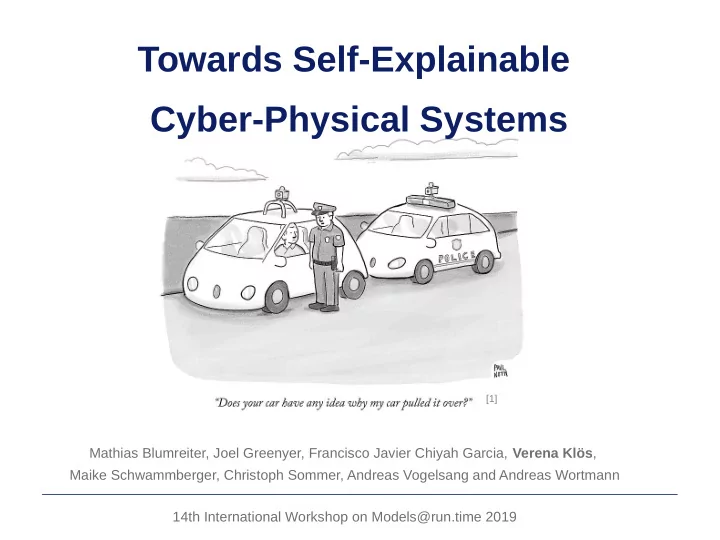

Towards Self-Explainable Cyber-Physical Systems [1] Mathias Blumreiter, Joel Greenyer, Francisco Javier Chiyah Garcia, Verena Klös , Maike Schwammberger, Christoph Sommer, Andreas Vogelsang and Andreas Wortmann 14th International Workshop on Models@run.time 2019
Motivation uncertainties safety-critical autonomous dynamic networks decisions run-time evolution TRUST ??? Verena Klös et. al | Towards Self-Explainable CPS 2
Vision explanation of past & current behavior It’s too cold! Warm water will be available in 20 minutes. Why? You normally don’t shower before 7 a.m. The water boiler starts heating How can I At 6.30 a.m. to save energy. change this? I found three options: 1) switch off energy saving 2) manually enter starting time 3) let me sync with your alarm answer questions about the system’s future behavior Verena Klös et. al | Towards Self-Explainable CPS 3
The MAB-EX Loop for Explainability Self-Explaining: - autonomously detect need for explanations - provide recipient-specific explanations - learn from observations & interactions A P M E Knowledge Models Managed System MAPE-K Loop from IBM [2] Verena Klös et. al | Towards Self-Explainable CPS 4
Example: V2X driver assistance system Verena Klös et. al | Towards Self-Explainable CPS 5
Monitor example: position of the car, answer of the controller relevant sensor data commands from controller components user and/or system interactions & former explanations Verena Klös et. al | Towards Self-Explainable CPS 6
Analyze example: car on lane L1 and enteringDisallowed? process explanation queries from recipient detect behavior that requires an explanation (e.g., irregularities in the monitored sensor data, sudden changes in the user interactions) Verena Klös et. al | Towards Self-Explainable CPS 7
Build evaluate explanation model to build explanation contains causal relationships between events and system reactions → traces of events → look-ahead simulation (“What happens if ... ?”, “When will ... be possible again?”) Verena Klös et. al | Towards Self-Explainable CPS 8
Example: Models of Causality Approach [3] easy to model & integrate limited to anticipated phenomena & past/current situations Verena Klös et. al | Towards Self-Explainable CPS 9
Example: Explanations from Run-Time Models Scenario Modeling Language [4] can be queried and executed for look-ahead predictions higher modeling effort Verena Klös et. al | Towards Self-Explainable CPS 10
Explain example: “Entering is disallowed because other cars are passing the obstacle in the opposite direction and a priority vehicle is registered for passing the obstacle“ understandable explanation for the recipient based on recipient model: mental model of a human explanation interface between different systems → explanation format, level of abstraction, points of interest Verena Klös et. al | Towards Self-Explainable CPS 11
EX-Model Learning system and recipient may evolve over time uncertainties at design time (about the system behavior, operational context, and the recipient and its preferences) → update explanation model and recipient model possible realizations: machine learning algorithms, expert system, learning from user reactions Verena Klös et. al | Towards Self-Explainable CPS 12
Summary Why? What happens if ..? How can I achieve ..? Verena Klös et. al | Towards Self-Explainable CPS 13
References [1] https://www.newyorker.com/cartoon/a19697?verso=true [2] “An Architectural Blueprint for Autonomic Computing,” IBM, White Paper, Jun. 2005. [3] F. J. Chiyah Garcia, D. A. Robb, X. Liu, A. Laskov, P. Patron, and H. Hastie, “Explain Yourself: A Natural Language Interface for Scrutable Autonomous Robots,” in Explainable Robotic Systems Workshop (HRI), 2018. [4] J. Greenyer, D. Gritzner, T. Gutjahr, F. König, N. Glade, A. Marron, and G. Katz, “ScenarioTools – A tool suite for the scenario-based modeling and analysis of reactive systems,” Elsevier Science of Computer Programming, vol. 149, pp. 15–27, 2017, Special Issue on MODELS’16. Verena Klös et. al | Towards Self-Explainable CPS 14
Recommend
More recommend